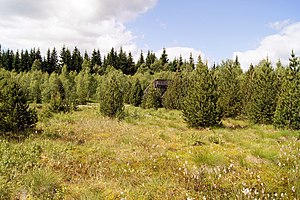Mothhäuser heather
|
Mothhäuser Heide nature reserve
|
||
|
Stengelhaide area in the NSG Mothäuser Heide (2012) |
||
| location | Marienberg , Saxony , Germany | |
| surface | 4.141 km² | |
| Identifier | C 13 | |
| WDPA ID | 14525 | |
| Geographical location | 50 ° 36 ' N , 13 ° 13' E | |
|
|
||
| Setup date | 2003 | |
The Mothäuser Heide not far from the Marienberg district of Kühnhaide is the oldest moor and conservation area in the Ore Mountains . It has the status of a nature reserve and is also a fauna and flora habitat .
The moor is located northwest of Kühnhaide in the central Ore Mountains not far from the German-Czech border. With an altitude of 729 to 773 m above sea level. NN is the area on the ridge.
Origin and use
The oldest bog formations in the Ore Mountains emerged at the earliest about 9,000 years ago. The first bog formations emerged where mineral-rich, acidic water came to light. The Erzgebirge moors - including the Mothäuser Heide - are low mountain range rain moors .
All types of moor use are preceded by drainage. The influence of the Erzgebirge moors is generally closely linked to the history of mining and settlement in this area.
To make it usable, a dense system of ditches (71 km long and up to 4.5 meters deep) was dug, peat was cut, spruce trees and spikes were planted. The economic use extended demonstrably over the period from 1818 to 1854. The clearing of the trenches was finally given up in 1875 due to inefficiency.
Apart from forestry interventions in the edge zones and immissions - here in particular SO 2 - an undisturbed regeneration of the moor has been going on for 120 years. In the 1990s the moorland was transferred from the Free State of Saxony to a real estate agent for the sum of 1 million DM . Through this, wood was later felled in such a way that the protected area threatened to dry out. He later sold the area again for more than 4 million DM.
meaning
The area was declared a protected area as early as 1911, and in 1960 parts of this protected area were given total reserve status. The moor itself extends over an area of 124 hectares , the nature reserve is designated with 414.1 hectares and the FFH area with an area of 663 hectares.
The Mothhäuser Heide represents a relatively large and intact high moor landscape. The peat layer grows annually by about 1 millimeter and in the core of the area reaches a thickness of about 8 meters.
The water storage volume corresponds roughly to that of the Neunzehnhain I dam near Lengefeld , which is around 0.54 million m³.
vegetation
In the course of various work, the moor was measured, its development described, the vegetation determined and compared with previous vegetation maps in order to examine changes.
Plant species (selection):
- Dwarf birch ,
- Scabbard cotton-grass ,
- Round-leaved sundew
- Common cranberry
- Rosemary heather
- European seven star
- blueberries
literature
- Hedwig Frenzel: Development history of the Saxon moors and forests since the last ice age. Treatises of the Saxon Geological State Office, No. 9, Dresden, 1930
- Siegfried Sloboda: Origin, usage history, maintenance and development principles for Ore Mountains raised bogs. From: Ecology and protection of the high moors in the Ore Mountains, pages 10–31.
- Peggy Zinke: History of use, condition and revitalization of the moors in the Ore Mountains . TELMA, vol. 32, pp. 267-280.
Web links
- Sabrina Scharf: The current state of the Erzgebirge moors from a nature conservation perspective , TU Bergakademie Freiberg (PDF 204 kB)
- Siegfried Sloboda: Bogs and bog protection in Saxony (PDF 8.05 MB)
- Freie Presse Online: Berry collectors have no business in the core area of the Mothhäuser Heide
Individual evidence
- ↑ a b Flyer of the LRA Middle Erzgebirgskreis, Naturschutzstation Pobershau (Hrsg.): Particularly protected habitat raised bogs ( Memento of the original from November 16, 2010 in the Internet Archive ) Info: The archive link was automatically inserted and not yet checked. Please check the original and archive link according to the instructions and then remove this notice. (PDF 350 kB), accessed on February 3, 2011
- ↑ Deutschlandfunk program magazine: Protected areas in need. Has nature degenerated into a commodity? , Cologne 2017, issue 7/2017-July, p. 89
- ↑ sz-online.de : Halali in the reserve - With its nature reserves, the Free State has not shown a lucky hand , accessed on February 3, 2011
- ↑ sachsen.de - Forest and forestry: Leitbiotop Moor areas and other wetlands ( page no longer available , search in web archives ) Info: The link was automatically marked as defective. Please check the link according to the instructions and then remove this notice. , accessed February 3, 2011





